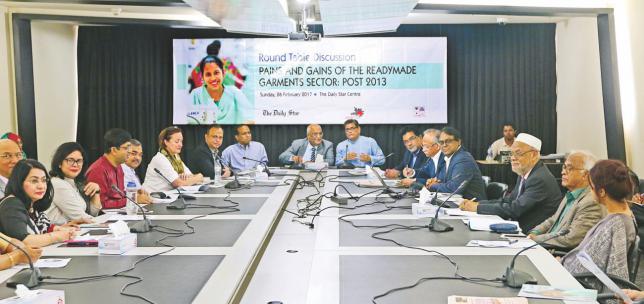Source: The Daily Star
Bangladesh will have to address three important factors -- higher productivity, workers' wage hike and profitability -- for sustainability of the apparel sector, said an economist yesterday.
These three factors should work together to improve the sector's competitiveness, said Debapriya Bhattacharya, distinguished fellow of the Centre for Policy Dialogue. There needs to be effective social dialogue to resolve some outstanding issues in the garment sector and to save the entrepreneurs, he suggested. He also suggested retailers, suppliers and other stakeholders share the remediation cost of factories to reduce the burden on manufacturers.
Bhattacharya said the garment sector survived and reached its present position by overcoming major challenges, including the shock of a quota-free era, child labour, fallouts from global financial meltdown, and finally, the Rana Plaza building collapse that happened in 2013. He was moderating a discussion on 'Pains and Gains', a research paper on the progress made, impediments and the future of the garments sector. The Daily Star and Bangladesh University jointly organised the discussion on the outcomes of the research conducted by Wamiq Umaira and Mahmood Hussain, at The Daily Star Centre in Dhaka.
Rubana Huq, managing director of Mohammadi Group, said apparel makers want to brand Bangladesh as the most compliant supplier. Investment in social dialogue is crucial at this moment, she said. “We need to brand ourselves better.” The recent unrest at Ashulia showed that Bangladesh needs further engagement of stakeholders. Manufacturers have been spending millions of dollars on remediation and relocation of the factories. Unavailability of workers is a major challenge in the case of relocation of the factories, she said.
Fahmida Khatun, research director of CPD, said garment manufacturers should increase workers' wages in addition to carrying out the remediation works. Nazma Akter, president of Sammilito Garment Sramik Federation, a rights group, said the harassment of the workers and unionists should be stopped.
“We need to protect the voices of the workers and unionists,” she said, demanding fair wages for workers. Bangladesh will face challenges in becoming a middle income country if workers' wages are not increased, Akter said. “We need real participation and real social dialogue.”
Debbie Coulter, head of programme of Ethical Trading Initiative, said the voice of workers needs to be heard in terms of health and safety.
Toufik Ali, former Bangladesh ambassador to Geneva, said the Bangladesh Garment Manufacturers and Exporters Association has an important role in resolving the disputes.
Miran Ali, a director of BGMEA, said more than 90 percent factories in Vietnam and Cambodia are owned by foreign investors. The scenario in Bangladesh is completely different -- more than 90 percent factories here are owned by local entrepreneurs, he added. A problem with entrepreneurship here is that many factories might not be able to sustain the current improvement due to financial constraints, he added.
Mahmud Hasan Khan, vice-president of BGMEA, said, “We are spending a lot of money on relocation.” There were more than 6,000 BGMEA member factories a few years ago, but now, the number came down to around 2,900. Buyers are not paying higher prices for garment products in Bangladesh, although they offer higher rates in China, India, Vietnam and Pakistan. This is not a level playing field, he said.
Remediation costs a garment factory $614,000 or Tk 4.9 crore on average, according to the new survey. The findings were based on the learning and remediation measures adopted since the Rana Plaza tragedy of 2013. After the industrial disaster, western buyers began inspection of local factories through two platforms – the Alliance and the Accord. They have together inspected 2,500 out of 3,660 factories in the country.
Some 33 factories of different sizes were surveyed and their total expenditure for the remediation was over $20 million. The amount, however, did not include other implicit costs, such as the production loss owing to factory relocation, the ongoing remediation process and migration of skilled workers. Most of the factories surveyed were established in 2002 and each earns between $15 million and $30 million a year.
A factory, which is categorised as large in the sample, earns $50 million a year. The report found most factories faced multiple challenges in implementing the remediation recommendations.


